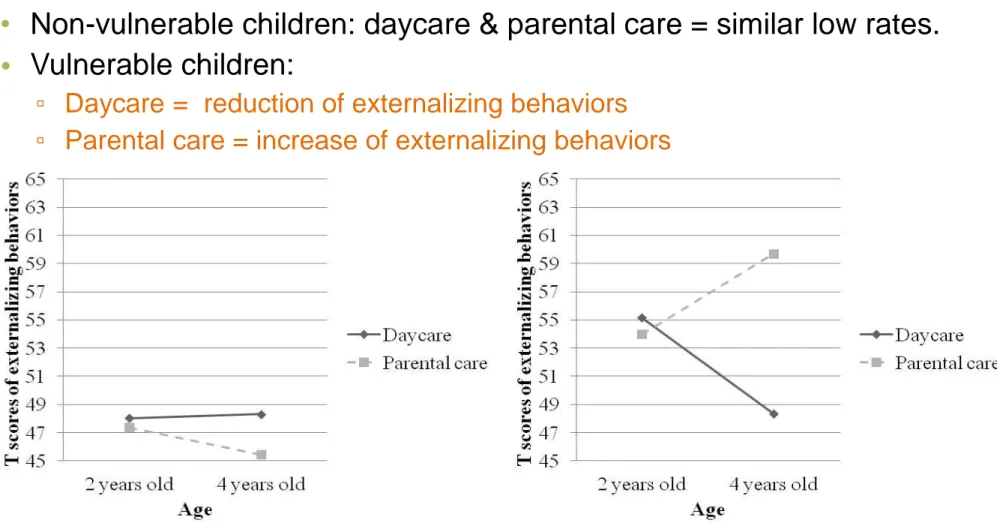Educational daycare from infancy
and externalizing and internalizing
behaviors in early childhood:
differential effect by children's
vulnerability
Lise Lemaya
Nathalie Bigrasa
Caroline Bouchardb
a Université du Québec à Montréal, Montréal (QC) Canada B Université Laval, Québec (QC),Canada
Context
•
Québec (Canada) = network of regulated daycares
offering an educational program for children from birth
to school entry, for $5 per day from families ($7 per day
since 2004).
▫ 214,804 children are attending, the majority in non-profit centers (82,671 spots) and homes (91,607 spots).
▫ First transition between the family and an educational setting.
Educators have the task of ensuring that children acquire behaviors that promote adaptation in a group.
This early educational experience could ensure fewer externalizing and internalizing behaviors.
Previous research - non-vulnerable
children
•
Inconsistency of results
▫ Higher rates of externalizing or internalizing behaviors
(Côté et al., 2008; Hickman, 2006; Loeb et al. 2007; Van Beijsterveldt, Hudziak & Boomsma, 2005).
▫ Lower rates of externalizing or internalizing behaviors
(Bigras et al., 2009; Hickman, 2006)
▫ No differences
(Bacharach & Baumeister , 2003; Bigras et al., 2009; Côté et al., 2008; Van Beijsterveldt, Hudziak & Boomsma, 2005)
•
Limits
▫ Children's vulnerability isn't considered in these
results.
Previous research - vulnerable children
•
Some focused on children exposed to risk factors in
their home.
▫ Associated with less-positive socialization processes
that place children at a greater risk of following
less-favourable trajectories.
▫ Educational daycare = compensatory environment?
•
Daycare attendance initiated in the first year of life
is associated with less externalizing and
internalizing behaviors.
Objective
•
This study compare externalizing and internalizing
behaviors at 2 and 4 years-old between children,
non-vulnerable and vulnerable, attending an
educational daycare and those remaining under
parental care from their first year of life.
Method
Subjects
• 66 healthy participants recruited between 5-12 months old
▫ 45 children in daycare (6 vulnerable)
▫ 21 children under parental care (7 vulnerable).
Measures
Procedures
• 2 X 2 X 2 mixed-design
▫ Child's vulnerability (vulnerable or non-vulnerable) and type of care (daycare or parental care) = between-subject
▫ Child's age (2 and 4 years old) = within-subject
1 year old 2 years old 4 years old Externalizing and internalizing behaviors (CBCL 1.5/5; Achenbach & Rescorla, 2000) X X Type of care (Childcare experience questionnaire; Lemay & Bigras, 2006) X
Results
– Externalizing behaviors
Significant interaction between child' age, type of care and vulnerability, explaining
10.83% of the externalizing behaviors variance.
Suggest that the effect of type of care on externalizing
behaviors at 2 and 4 years old depend on child's vulnerability.
df SS MS F p ƞ2 Between-subjects Type of care (T) 1 54.66 54.66 0.46 0.50 0.64 Vulnerability (V) 1 970.68 970.68 8.25 0.01* 11.35 T X V 1 232.90 232.90 1.98 0.16 2.72 Error 1 62 7295.98 117.68 Within-subject Age (A) 1 9.41 9.41 0.28 0.60 0.38 A X T 1 131.40 131.40 3.95 0.05* 5.31 A X V 1 0.34 0.34 0.01 0.92 0.01 A X T X V 1 267.84 267.84 8.05 0.01* 10.83 Error 2 62 2063.54 33.28 †p < 0.10; *p < 0.05
Results
– Externalizing behaviors
• Non-vulnerable children: daycare & parental care = similar low rates.
• Vulnerable children:
▫ Daycare = reduction of externalizing behaviors ▫ Parental care = increase of externalizing behaviors
Results
– Internalizing behaviors
Significant interaction between child' age, type of care and vulnerability, explaining 4.52% of the internalizing behaviors variance.
Suggest that the effect of type of care on internalizing
behaviors at 2 and 4 years old depend on child's vulnerability.
df SS MS F p ƞ2 Between-subjects Type of care (T) 1 654.16 654.16 5.05 0.03* 6.47 Vulnerability (V) 1 1109.06 1109.06 8.57 0.01* 10.97 T X V 1 321.70 321.70 2.48 0.12 3.18 Error 1 62 8028.02 129.48 Within-subject Age (A) 1 6.27 6.27 0.17 0.68 0.24 A X T 1 149.54 149.54 4.06 0.05* 5.80 A X V 1 18.11 18.11 0.49 0.49 0.70 A X T X V 1 116.53 116.53 3.16 0.08† 4.52 Error 2 62 2285.79 36.87 †p < 0.10; *p < 0.05
Results
– Internalizing behaviors
• Non-vulnerable children: daycare & parental care = similar low rates.
• Vulnerable children:
▫ Daycare = higher internalizing behavior at 2 years old, but reduction afterward ▫ Parental care =increase in internalizing behaviors
Discussion
•
Effect of type of care on children' externalizing and
internalizing behaviors from 2- to 4- year-old is
moderated by children' vulnerability.
•
Vulnerable children
▫ Ecosystemic model = child X environment interactions. ▫ Daycare = compensative educational environment.
▫ Educators need to adopt practices that create a high-quality environment.
(Gouvernement du Québec,2007)
▫ Is it always the case?
Borderline scores of children in daycare at 2 years old.
Educators not as familiar with the internalizing behaviors of vulnerable 2-year-old?
Discussion
•
Non vulnerable children
▫ No differences between daycare and parental care.
▫ A particularity Quebec's network of regulated daycares associated with higher quality?
Countries regulating early childhood education tend to offer homogeneous higher quality.
(Sheridan & Schuster, 2001)
High quality less externalizing and internalizing behaviors.
(Crockenberg & Leerkes, 2005; NICHD, 1998)
•
Hypothesis
▫ Associations with quality of educator’s practices still need to be verified.
Conclusion
•
This study suggests that:
▫ Non vulnerable children - daycare attendance associated with the same normal externalizing and internalizing
behaviors as parental care from 2 to 4 years of age.
▫ Vulnerable children - daycare attendance associated with a reduction in externalizing and internalizing behaviors from 2 to 4 years of age, but internalizing behavior scores still remain higher.
•
Further work features of the educational experiences
that contributed to attain these normal rates.
▫ Ensure the socialization goal of the daycare network is fully reached for all children and all types of behaviors.

